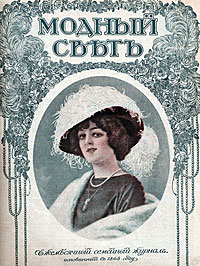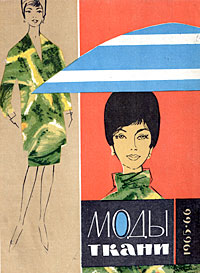Magazines from 1901-1917
Magazines from 1920-1941
Magazines from 1945-2003
Exhibition Catalogue
 As part of the 23rd week of fashion "Defile on the Neva River", an unusual exhibition Fashion Bulletins, which covers the nearly 250-year history of fashion periodicals in Russia, was held in April 2011 in the Korff Hall of the Main Building of the NLR .
As part of the 23rd week of fashion "Defile on the Neva River", an unusual exhibition Fashion Bulletins, which covers the nearly 250-year history of fashion periodicals in Russia, was held in April 2011 in the Korff Hall of the Main Building of the NLR .
The history of European fashion magazines began in the 17th century, but in Russia they first appeared only in the late 18th century when private people were permitted to engage in publishing.
In 1779, the magazine Modnoe ezhemesyachnoe izdanie, ili Biblioteka dlya damskogo tualeta [Monthly Fashion Publication, or the Library for Ladies' Dressing] came out in Moscow. For the first time, the word "fashion" was used in a Russian journal title. Pictures of clothes with funny inscriptions in Russian, such as An Overdressed Woman on a Stroll, The Cap of Victory, Exposed Charms, were issued as an supplement. French women's fashion garments of that time were subjected to light ridicule by the publisher of the French original. Nevertheless, these pages are considered to be an example of Russian fashion illustration.
Women from aristocratic families were very pleased with the birth of Damskiy zhurnal [Ladies' Magazine] in 1827. The publication, providing readers with the latest Parisian dress designs and placing the first colour illustrations, was the very thing that socialites needed. The Listok dlya svetskih lyudey [Sheet for People of Society], issued in St. Petersburg in 1843, read, 'Our piece of writing ordered pictures directly from Paris, namely, images of large format, perfectly done, printed on the best satin paper - in short, worthy to be framed in glass.'
In the late 50-s of the 19th century, there were more than thirty journals such as the Merkuriy mod [Mercury of Fashion], Vestnik parizhskoy modyi [ Bulletin of Parisian Fashion] and Moskovskiy telegraf [Moscow Telegraph], covering subject matters important to ladies. Supplements to them featured current fashion trends from Paris, etc. These publications can easily be regarded as the precursors of modern women's magazines. In addition to parenting and educational topics, they offered more and more articles for hand needlework packed with drawings in the text and colour embroidery designs along with sewing patterns in the supplement. Women of various age could find here instructions for embroidery and sewing they were interested in. The magazines Sandrilona[Cinderella] and Damskiy albom rukodelnyih rabot [Ladies' Album of Needlework] were especially loved for large sheets of coloured pictures of embroidery designs and sewing patterns.
In the late 19th/ early 20th century, in connection with the evolution of printing technologies, many new fashion magazines, which used photographs and high-quality reproductions, were created. The most famous at that time were magazines Damskiy mir [Ladies' Wold], Domashnyaya portniha [Home Dressmaker], Modnyiy svet [Fashion Society], Modnyiy magazin [Fashion Shop], fashion supplements to the magazines Nov'[Modern Age] and Niva [Grainfield].
 Many people mistakenly believe that there was no fashion in Russia during the Soviet era. In reality, there were ateliers and fashion houses, specialized literature and magazines. However, it was felt that a management style in this field was authoritarian , designers did not show their individuality. Mass production of clothing determined the nature of the publications in the 1930s (Albom modeley odezhdyi shveynoy promyishlennosti RSFSR [Album of Clothes of the Garment Industry of the RSFSR]), while the Iron Curtain, descended in the end of the decade, blocked the fresh wind from Europe.
Many people mistakenly believe that there was no fashion in Russia during the Soviet era. In reality, there were ateliers and fashion houses, specialized literature and magazines. However, it was felt that a management style in this field was authoritarian , designers did not show their individuality. Mass production of clothing determined the nature of the publications in the 1930s (Albom modeley odezhdyi shveynoy promyishlennosti RSFSR [Album of Clothes of the Garment Industry of the RSFSR]), while the Iron Curtain, descended in the end of the decade, blocked the fresh wind from Europe.
In 1944 the Government commissioned the newly established Moscow Fashion Hause to create new models of clothes for the post-war period. Once again, the authoritarianism of the officials was reflected in the title: Albom modeley verhnego platya, prinyatyih na vsesoyuznom prosmotre [Album of Models of Coats Approved at the All-Union Show] (1945).
During the Thaw in the 1960s, the number of publications devoted to the questions of fashion, sewing, needlework increased. Like in the 19th century, supplements to women's magazines, publishing patterns and drawings, sprang up. During the 1970s - 80s, independent publications entitled Modeli GUMa [Clothes of GUM] were issued by GUM (Moscow State Department Store) - these were albums of seasonal clothing. In subsequent years, integration with European fashion trends was made possible thanks to Western journals published in Russian (Burda, Harper Bazaar, Vogue, etc.)
The exhibition provided a retrospective of publications that were issued in the Imperial Russia, the USSR and Modern Russia. At all times, these publications help millions of people to get used to new fashion, because it is not just for catwalks and photo shoots, but first and foremost for people. The distinctive feature of the exhibition is that it allows you to trace not only the development of fashion trends, but also changing attitudes towards fashion in the periodicals in the times indicated above.
You can also view fashion magazines in the Digital Library of the NLR (unfortunately, the English language interface is not available) as well as
the online exhibition 15-18th Century Women's French Court Dress
The Exhibition Curators
N. Malysheva, E. Pugina.


